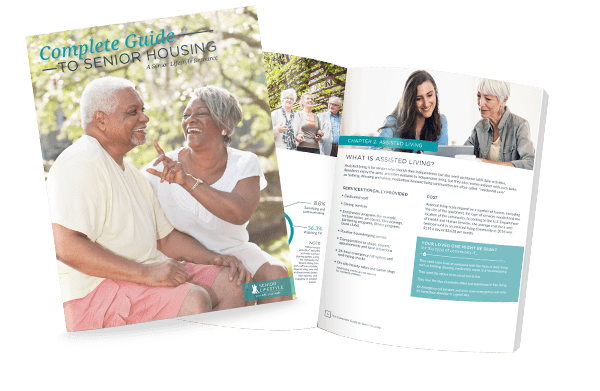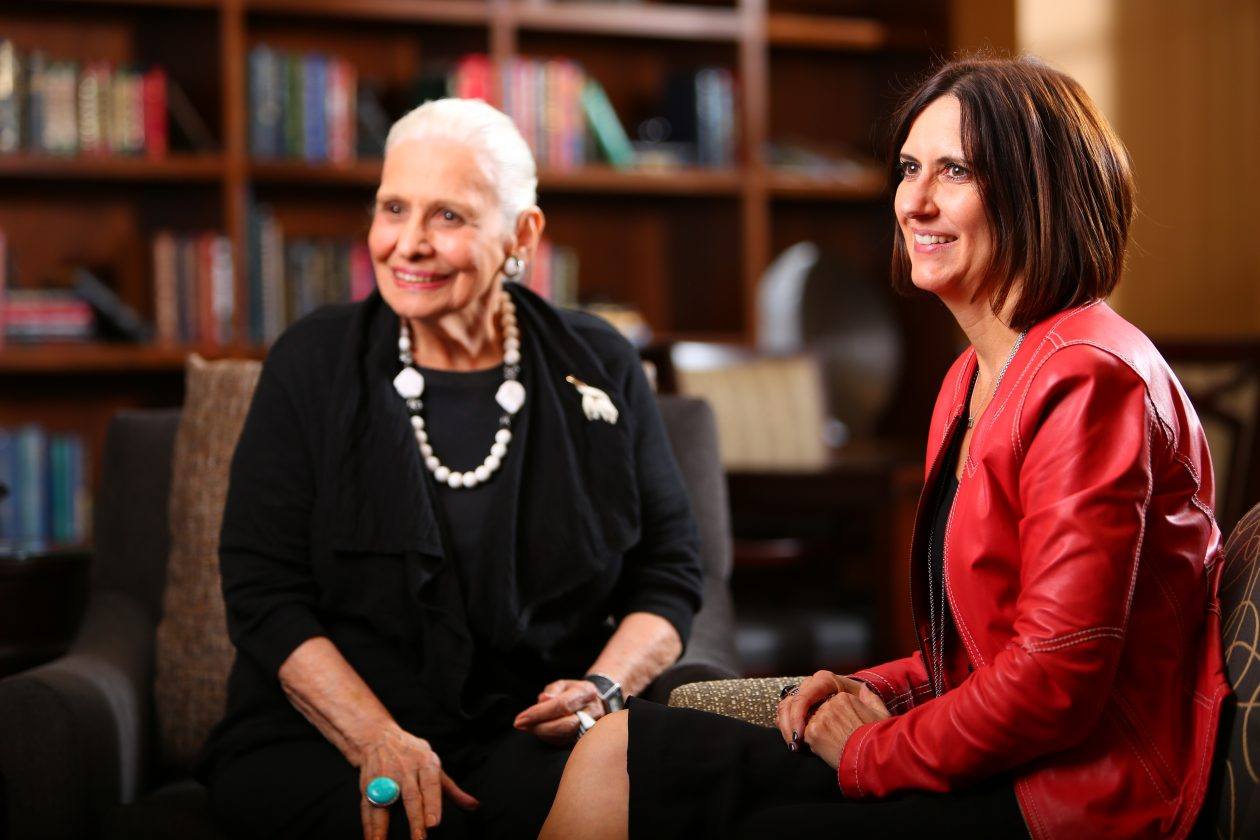When it’s time to start looking for a place for mom – or any older adult in your care – the first place many of us turn to is the internet. With more than 190 communities in 28 states, we consider ourselves to be experts when it comes to caring for our aging parents.
This checklist will help you understand what to look for as you evaluate options, and we’ll cover the various senior living options that are available to us as we age.
What to look for when you search for a place for mom
Senior services
- Does the community offer a continuum of care? In other words, as your parents’ needs change, will the community’s services adapt along with them?
- What kinds of community partnerships does the home have?
- What is the staff-to-resident ratio?
- What financial solutions are available, and does the community offer consultation on financial resources?
- Is there a calendar of events that is updated regularly?
- What will your parents’ first day/week/month look like at community? What will a typical day entail?
Staff communication, community relations, culture
- Is the community welcoming? How did they make you feel when they answered your first phone call?
- How do they protect their residents’ privacy and dignity?
- Does the team members seem to like and respect each other?
- What kinds of enrichment programs do they offer?
- How long has the management company been in business?
Maintenance, housekeeping, aesthetics
- How well is the property maintained? Is it well-maintained outside, in common areas and in residents’ apartments?
- Would you feel happy living and visiting here? Is it home-like?
- What is the surrounding neighborhood like? Is it quiet? Safe?
- Is the community safe and secure? What security system does the location use?
- Are housekeeping, maintenance and laundry services included, or are they extra?
Medical care and support
- How close is the nearest hospital?
- How easy are the emergency call devices to reach?
- What efforts does the team members make to engage with residents?
- Are there specialists who work with residents to make sure they have access to the right resources and programs?
- What healthcare providers are included? Do they offer physical therapy, mental health and other types of services?
- What services are included in the monthly fee?
Dining and meal services
- Visit during mealtime. How does it smell? How does the food look? Can you try a few meals? What’s a typical menu look like?
- Are residents encouraged to socialize during mealtimes? Does team members facilitate introductions and conversations?
- What type of dietary and nutrition support is on staff? Does the dining room accommodate special dietary needs and preferences?

Download The Complete Guide to Senior Housing
Every senior has their own set of wants and needs, so retirement communities offer differing levels of care, services, and amenities. Read our eBook for a detailed look at what retirement communities provide.
Download the GuideYour options for your aging parents
The right choice for your parents depends on how much care is required. Even if they are fully independent and can prepare meals, run errands, do household chores, and care for themselves today, their needs can change tomorrow.
As we age, mobility issues can arise and simple tasks become more difficult, like going up and down stairs, carrying in groceries or mowing the lawn.
This section explores living options for aging adults, from staying in place and aging at home to fully staffed skilled nursing homes.
Aging in place
Aging in the home – also known as aging in place – means exactly what it sounds like: Choosing to live in your own home for as long as possible. There’s something comforting and convenient about living as long as possible in a place where you raised your family and celebrated life’s milestones.
Seniors may choose an alternative other than aging in place for a number of reasons:
- They have mobility issues that make going up and down stairs of a multi-level home difficult.
- They need to be closer to their doctors, healthcare providers, and hospitals.
- Maintenance and repairs on their home have become too much work, and they’re no longer physically able to do it themselves.
- They’re lonely. Friends and family are busy – and traveling to see them isn’t easy – and they want to live in an active community surrounded by people like them.
- They have medical issues that need round-the-clock attention and support.
Aging in place is the best option for people who can take care of themselves and have a strong round-the-clock support community, such as friends, family, neighbors or home health staff.
Age-restricted communities
Age-restricted communities are typically for adults age 55 and older. Sometimes they’re referred to as retirement communities, because they cater to lifestyles of retired adults.
Age-restricted communities may be gated, and many of them have community recreation centers that offer group social activities, clubs, entertainment and events. Some age-restricted communities are called niche retirement communities because they cater to specific interests, such as golf.
Like aging in place, the age-restricted community is ideal for adults who are able to care for themselves and have a strong support system comprised of family, friends and neighbors.
Senior housing
The definition of “senior housing” tends to depend on who you’re talking to. Some people use the term to refer to any kind of housing that caters to older adults, including everything from age-restricted communities to skilled nursing homes. Others refer to senior housing as HUD-approved apartment units that have been approved for senior citizens.
Independent living
You may find some sources that use “independent living” interchangeably with “retirement community.” We refer to independent living as apartment-style living that’s staffed around the clock. Independent living at Senior Lifestyle means:
- 24-hour on-site staff
- Routine housekeeping, maintenance and repairs
- Emergency call systems
- On-site restaurant-style dining prepared by our team of dining experts
- Life Enrichment Programs
- Common areas for socializing and hosting special events
Senior independent living is ideal for aging adults who want all the perks of living independently and all the benefits of living in a retirement community.
Assisted living
Assisted senior living is similar to independent living, but it offers assistance with daily living, which may include help with:
- Bathing, dressing and self-care
- Medication administration and assistance
- Healthcare, such as physical therapy
- Daily meals
- Transportation to and from appointments
Assisted living allows your parents to live independently in their own apartment while having assistance when they need it. As you evaluate options for them, look for senior living communities that tailor programs to residents’ needs, especially as they age and their needs change.
Skilled nursing at senior nursing homes
Skilled nursing communities are also referred to as nursing homes, because they employ round-the-clock licensed nurses and other rehabilitative healthcare. Typically these types of homes offer short-term and long-term care options.
Short-term stays typically happen after an injury, illness or operation, or because someone has a complicated medical condition that requires 24-hour care. The nursing team members coordinates care with your healthcare providers and will transport them to medical appointments.
Which option is best for your aging parents?
As you explore your options, you’ll notice that many of Senior Lifestyle’s communities offer several levels of care that include independent living, assisted living, memory care and nursing care.
“Helping your parents age gracefully, happily and safely is no small task,” says Janine Witte, National Director of Sales. “It takes time and patience, both of which can be hard to come by, especially when you’re worried about their health and welfare.”
She suggests that you start by talking to friends, other family members and coworkers who may have gone through a similar situation with their parents.
“We’ve seen people post questions on social media asking their friends and family for advice on finding places for their aging parents.” Janine says. “That’s not a bad place to start.”
She suggests searching for “assisted living near me” or looking at the Senior Lifestyle website, which manages senior communities in 28 states. You can search by city, state, ZIP code and name.
Make a list of the most important features you and your parents want in a home, and then group them by “must have” and “optional.”
As you narrow your list of senior living options, schedule tours for you and your parents. Ask if it’s OK to take photos, so you can remember features you liked, as well as features that brought up concerns.
“Ultimately, you want to find the place for mom and dad that’s going to care for them as if they’re family,” Janine says.

